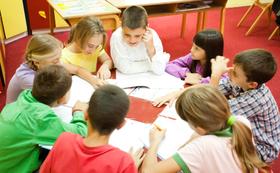Top Rankings
Thomas Edison School District ranks among the top 20% of public school district in Utah for:
Category
Attribute
Overall Rank
Highest overall rank (Top 20%)
Math Proficiency
Highest math proficiency (Top 10%)
Science Proficiency
Highest science proficiency (Top 20%)
For the 2025-26 school year, there are 2 public charter schools serving 1,203 students in Thomas Edison School District. This district's average charter testing ranking is 9/10, which is in the top 20% of public charter schools in Utah.
Public Charter Schools in Thomas Edison School District have an average math proficiency score of 61% (versus the Utah public charter school average of 38%), and reading proficiency score of 50% (versus the 39% statewide average).
Minority enrollment is 24% of the student body (majority Hispanic), which is less than the Utah public charter school average of 36% (majority Hispanic).
Overview
This School District
This State (UT)
# Schools
2 Schools
143 Schools
# Students
1,203 Students
79,969 Students
# Teachers
58 Teachers
4,131 Teachers
Student-Teacher Ratio
21:1
21:1
Student By Grade
District Rank
Thomas Edison School District, which is ranked within the top 20% of all 153 school districts in Utah (based off of combined math and reading proficiency testing data) for the 2022-2023 school year.
Overall District Rank
#25 out of 154 school districts
(Top 20%)
(Top 20%)
Math Test Scores (% Proficient)
61%
40%
Reading/Language Arts Test Scores (% Proficient)
(20-21)49%
43%
Science Test Scores (% Proficient)
(20-21)54%
45%
Students by Ethnicity:
Diversity Score
0.40
0.53
% American Indian
n/a
n/a
% Asian
3%
3%
% Hispanic
17%
25%
% Black
1%
2%
% White
76%
64%
% Hawaiian
1%
2%
% Two or more races
2%
4%
All Ethnic Groups
District Revenue and Spending
The revenue/student of $7,851 in this school district is less than the state median of $10,732. The school district revenue/student has stayed relatively flat over four school years.
The school district's spending/student of $6,922 is less than the state median of $10,829. The school district spending/student has stayed relatively flat over four school years.
Total Revenue
$9 MM
$7,309 MM
Spending
$8 MM
$7,375 MM
Revenue / Student
$7,851
$10,732
Spending / Student
$6,922
$10,829
Best Thomas Edison School District Public Charter Schools (2025-26)
School
(Math and Reading Proficiency)
(Math and Reading Proficiency)
Location
Quick Facts
Rank: #11.
Thomas Edison - South
Charter School
(Math: 66% | Reading: 53%)
Rank:
Rank:
9/
Top 20%10
1275 W 2350 S
Logan, UT 84321
(435) 752-0123
Logan, UT 84321
(435) 752-0123
Gr: K-8 | 716 students Student-teacher ratio: 22:1 Minority enrollment: 20%
Rank: #22.
Thomas Edison - North
Charter School
(Math: 55% | Reading: 45%)
Rank:
Rank:
8/
Top 30%10
180 E 2600 N
Logan, UT 84341
(435) 787-2820
Logan, UT 84341
(435) 787-2820
Gr: K-8 | 487 students Student-teacher ratio: 19:1 Minority enrollment: 30%
Recent Articles

School Vouchers: Updated Pros and Cons (2025 Review)
Comprehensive 2025 analysis of school vouchers, weighing benefits and challenges for families, funding, outcomes, and policy directions.

Benefits and Drawbacks of Homework in 2025
Explore updated 2025 insights on homework’s benefits, drawbacks, mental health impact, best practices, and policy trends in U.S. public schools.

Charter Schools vs Public Schools 2025: Key Differences & Trends
Explore updated 2025 insights comparing charter schools vs public schools, enrollment, academic outcomes, funding, and real-world examples for families and educators.





